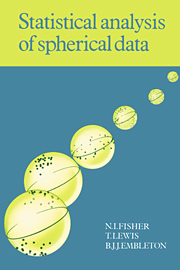Book contents
- Frontmatter
- Contents
- Preface
- 1 Introduction
- 2 Terminology and spherical coordinate systems
- 3 Descriptive and ancillary methods, and sampling problems
- 4 Models
- 5 Analysis of a single sample of unit vectors
- 6 Analysis of a single sample of undirected lines
- 7 Analysis of two or more samples of vectorial or axial data
- 8 Correlation, regression and temporal/spatial analysis
- Appendix A Tables and charts
- Appendix B Data sets
- References
- Index
1 - Introduction
Published online by Cambridge University Press: 06 January 2010
- Frontmatter
- Contents
- Preface
- 1 Introduction
- 2 Terminology and spherical coordinate systems
- 3 Descriptive and ancillary methods, and sampling problems
- 4 Models
- 5 Analysis of a single sample of unit vectors
- 6 Analysis of a single sample of undirected lines
- 7 Analysis of two or more samples of vectorial or axial data
- 8 Correlation, regression and temporal/spatial analysis
- Appendix A Tables and charts
- Appendix B Data sets
- References
- Index
Summary
What are spherical data? By a spherical measurement we simply mean the orientation of a straight line in space. In some scientific contexts we would wish to regard the line as directed, in others as undirected; in the first case we call it a vector and in the second case an axis.
Spherical data arise in many areas of scientific experimentation and observation. As examples of vectorial data from various fields, we instance from Astrophysics the arrival directions of showers of cosmic rays; from Structural Geology the facing directions of conically folded planes; from Palaeomagnetism the measurements of magnetic remanence in rocks; from Meteorology the observed wind directions at a given place; and from Physical Oceanography the measurements of ocean current directions. Examples of axial data from various fields include, from Crystallography the directions of the optic axes of quartz crystals in a sample of quartzite pebbles; from Astronomy the normals to the orbital planes of a number of comets; from Structural Geology the measurements of poles to joint planes or to axial plane cleavage surfaces; and from Animal Physiology the orientations of the dendritic fields at different sites in the retina of a cat's eye, in response to stimulus by polarised light.
Again, observations which are not in any way orientations can sometimes be usefully re-expressed in the form of orientations and analysed as spherical data; in Social Science, for example, it has been the practice to analyse data on occupational judgments by individuals as unit vectors.
- Type
- Chapter
- Information
- Statistical Analysis of Spherical Data , pp. 1 - 16Publisher: Cambridge University PressPrint publication year: 1987
- 1
- Cited by



